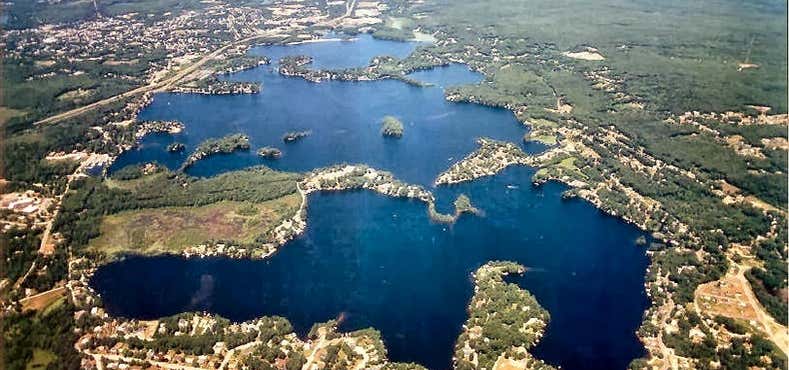What’s in a name? A lot, actually. Or, as is the case in Nothing, Arizona, not much. Whether a town’s name is intentionally meant to draw attention and tourist dollars, or a place comes by its strange moniker because of generations of alternate spellings, there’s usually a good story behind a unique name.
Here’s how seven places across the U.S. got their strange names.
Lake Chargoggagoggmanchauggagoggchaubunagungamaugg
We’ve all felt the pain of mispronouncing the name of a town in front of a local, but when it comes to a lake in the town of Webster, Massachusetts, most people are willing to give you a pass for butchering it—because there are no fewer than 45 letters in the name Lake Chargoggagoggmanchauggagoggchaubunagungamaugg.
Known as Webster Lake to locals who gave up on trying to pronounce the name a long time ago, Lake Chargoggagoggmanchauggagoggchaubunagungamaugg has the longest name among geographic features in the U.S., and one of the longest in the world. Algonquian-speaking peoples used several names and spellings in reference to the lake, including “Chabanaguncamogue” and “Chaubanagogum.” A 1795 map lists the name as “Chargoggagoggmanchoggagogg”; an 1830 survey of the lake uses “Chaubunagungamaugg”; and today, Central Massachusetts’ official website references the 45-letter version.
Rabbit Hash is an unincorporated hamlet on the Ohio River in Kentucky, where tradition and hospitality run deep. But the 7 square miles weren’t always called Rabbit Hash; the town’s first name was Carlton, but people started confusing it with the nearby town of Carrollton. Its new name was inspired by the 1847 flood, which forced the rabbit population to run to higher ground; legend has it that locals used the influx of protein to produce a hearty stew called rabbit hash—and the name stuck.
The strange name isn’t the hamlet’s biggest claim to fame: Since the late ‘90s, the town of 500 has elected a dog as its mayor. In 2020, a French bulldog named Wilbur took the ceremonial title. If you’re lucky, he might be at the Rabbit Hash General Store, a gathering point for locals and tourists, where you can buy a cold soda, handmade blankets, and Rabbit Hash merch.
Santa Claus Town Hall
Some people may say the Christmas spirit lives all year round in Santa Claus, Indiana, but come December, the town’s famous post office (the only one in the world with the Santa Claus name) receives more than 400,000 pieces of mail. In 1914, then-Postmaster James Martin started responding to every letter addressed to Santa at his own expense and for more than 100 years, letters from all over the world have been routed to Southwest Indiana where they’re answered by a team of volunteer “elves.”
Established in 1854 as Santa Fe, the town had to change its name 2 years later when it was discovered that there was already a Santa Fe, Indiana. Santa’s Candy Castle opened in 1935, and an iconic 22-foot-tall statue of Santa was built on the grounds that are now also home to the Santa Claus Museum and Village. Now called Holiday World & Splashin’ Safari, the world’s first theme park, Santa Claus Land, opened here in 1946.
The Town Of Phil Campbell, Alabama
Phil Campbell is one of two places in Alabama to be named after a person using their first and last name (the other is Susan Moore). Named for an 1880s engineer who built a railroad depot and stretch of track essential in developing the area, Campbell is located in the northwest corner of Alabama. In 1995, the town hosted a convention for other Phil Campbells—22 in total, and one Phyllis Campbell. Subsequent gatherings weren’t as successful, but Phil (or Phyllis) Campbells are still encouraged to visit their namesake town and check in at city hall.
Once called “Hot Springs,” Truth or Consequences, New Mexico, got its unique moniker thanks to a contest put on by the 1950s radio quiz show of the same name. The first town to rename itself “Truth or Consequences” won a live broadcast of the popular show; Hot Springs jumped at the chance, officially changing its name on March 31, 1950. For the next 50 years, the show’s host, Ralph Edwards, visited the town during the first weekend of May for an annual event (including a parade, rodeo, and music) known as Fiesta.
A Town Called Nothing
There aren’t a ton of surprises about the abandoned ghost town of Nothing, Arizona—but if you expect anything from a town called Nothing, then you’re not paying attention to the signs. Nothing was established and named in the late 1970s when Richard “Buddy” Kenworthy opened a gas station and convenience store in the otherwise-desolate region of western Arizona.
Despite the remote location (Nothing’s highest recorded population has been four people), the gas station operated until 2005, when it was shut down and sold. The new owner took out the gas pumps and fenced it off, but put it up for sale again. The third owner planned to reopen Nothing with a restaurant, but had a hard time getting his plan to open an eatery in the middle of nowhere off the ground. So now Nothing is back to being no more than a quick photo op—which is something.
Once known as Soda Springs, Zzyzx (pronounced “zy-zix”) is located at the end of the 4.5-mile, rural Zzyzx Road off Interstate 15 in San Bernardino County, California—just a short detour off Route 66. Curtis Howe Springer, a radio evangelist, minister, and self-proclaimed medical doctor, made up the name Zzyzx (the last word in the English language, he claimed) and bestowed it upon the area in 1944.
At Zzyzx Mineral Springs and Health Spa, Springer bottled and sold the region’s water to travelers and imported animals to attract visitors to his ranch. He used Zzyzx, which was on federal land, until 1974 when the government reclaimed the region; in 1976, the Bureau of Land Management (BLM) and California State University (CSU) established the CSU Desert Studies Center, and in 1994 Congress designated the former BLM land as the Mojave National Preserve under the National Park Service.
Roadtrippers
Roadtrippers helps you find the most epic destinations and detours—from roadside attractions to natural wonders and beyond.
Explore More Trip Guides
A Highway 1 road trip along California’s Central Coast
- 14 Places
- 02:49
- 99 mi
Route 66 Leg 2: St. Louis to Tulsa
- 61 Places
- 18:31
- 876 mi









